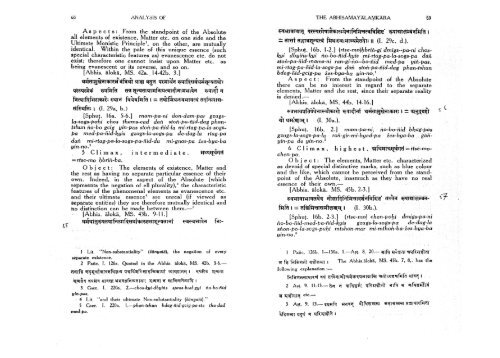ABHISAMAYALAMKARA
ABHISAMAYALAMKARA
ABHISAMAYALAMKARA
Create successful ePaper yourself
Turn your PDF publications into a flip-book with our unique Google optimized e-Paper software.
ANALYSIS OF<br />
Aspects: From the standpoint of the Absolute<br />
all elements of existence, Matter etc. on one side and the<br />
Ultimate Monistic Principle 1 , on the other, are mutually<br />
identical. Within the pale of this unique essence (such<br />
special characteristic features as) evanescence etc. do not<br />
exist; therefore one cannot insist upon Matter etc. as<br />
being evanescent or its reverse, and so on.<br />
[Abhis. aloka, MS. 42a.. 14-42b. 3.]<br />
ura mzmk<br />
(I. 29a, b.)<br />
[Sphut. 16a, 5-6.] rnam-pa-ni don-dam-par gzugsla-sogs-pahi<br />
chos thams-cad dan ston-pa-nid-dag phan-*<br />
tshun no-bo gcig yin-pas sioh-pa-nid-la mi-rtag-pa-la-sogs*<br />
pa med-pa-md-kyis gzugs-la-sogs-pa de-dag4a rtag-pa<br />
dan mi-rtag-pa-la-sogs-pa-nid-du mi-gnas-pa zes-bya-ba<br />
yin-no. 2<br />
5 Climax, intermediate. 3T^l|€iTff<br />
= rtse-mo hbrin-ba.<br />
Object: The elements of existence, Matter and<br />
the rest as having no separate particular essence of their<br />
own. Indeed, in the aspect of the Absolute (which<br />
represents the negation of all plurality), 3 the characteristic<br />
features of the phenomenal elements as evanescence etc.<br />
and their ultimate essence 4 are unreal (if viewed as<br />
separate entities) they are therefore mutually identical and<br />
ho distinction can be made between them.— 5<br />
[Abhis. aloka, MS. 43b. 9-II.J<br />
THE <strong>ABHISAMAYALAMKARA</strong><br />
(I. 29c. d).<br />
[Sphut. 16b. 1-2.] (rtse~mo)hbrih-gi dmigs~~pa-ni c/ioskyi<br />
dbyins~kyi no~bo-nid-kyis mi~rtag~pa-la~sogs-pa daft<br />
8ton*pa~nid-rnams~ni ran-gi~no—bo~fiid med-pa yin-pas.<br />
mi-rtag-pa-nid-la-'sogs-pa dan sioh~pa-nid-dag phan-tshun<br />
bdag-nid-gcig-pa zes-bya-ba yin-no. l<br />
Aspect: From the standpoint of the Absolute<br />
there can be no interest in regard to the separate<br />
elements, Matter and the rest, since their separate reality<br />
is denied.-—<br />
[Abhis. aloka, MS. 44b. 14-16.]<br />
(I 30a.).<br />
[Sphut. 16b.<br />
gzugs-la-sogs-pa-la<br />
yin-pa de yin-no. 2<br />
6 Climax<br />
chen-po.<br />
2.] rnam-pa-ni. ho-bo-hid bkag-pas<br />
ran-gir-mi-byed-pa zes-bya-ba gah~<br />
highest<br />
= rtse-mo-<br />
Object: The elements, Matter etc. characterized<br />
as devoid of special distinctive marks, such as blue colour<br />
and the like, which cannot be perceived from the standpoint<br />
of the Absolute, inasmuch as they have no real<br />
essence of their own.—•<br />
[Abhis. aloka. MS. 45b. 2-3.]<br />
*<br />
i = i (I. 30b.).<br />
[Sphut. 16b. 2-3.] (rtse-mo) chen-pohi dmigs-pa-ni<br />
no-bo-nid-med-pa-fiid'kyis gzugs-la-sogs-pa de-dag-la<br />
snon-po-la-sogs-pahi mtshan-mar mi-mthon-ba-zes-bya-ba<br />
yin-no. 3<br />
1 Lit. " Non-substantiality* * (siinyata), the negation of everjr<br />
separate existence.<br />
2 Pane. I. 126a. Quoted in the Abhis. aloka, MS. 42b. 36.—<br />
1 Pane 126b. 1—130a. 1.—Ast. 8. 20.— * T fq<br />
if ft ftfiftrat ^nm I<br />
T he Abhis.aloka, MS. 43b. 7, 8,. has the<br />
following explanation :—<br />
3 Gser, I. 220a. 2.—chos-kyi-dbyins spros-bral-gyi no-bo-nid<br />
yin-pas.<br />
* 4 Lit. "and their ultimate Non-substantiality (sunyata).*'<br />
5 Gser. I. 220a. 1.—phan-tshun bdag-nid-gcig~pa'$te tha-dad<br />
med~pa,<br />
2 A f t. 9. n-13.—<br />
3 Ast. 9. 13.












![Long Discourses of the Buddha [Digha Nikaya]](https://img.yumpu.com/32792419/1/164x260/long-discourses-of-the-buddha-digha-nikaya.jpg?quality=85)


